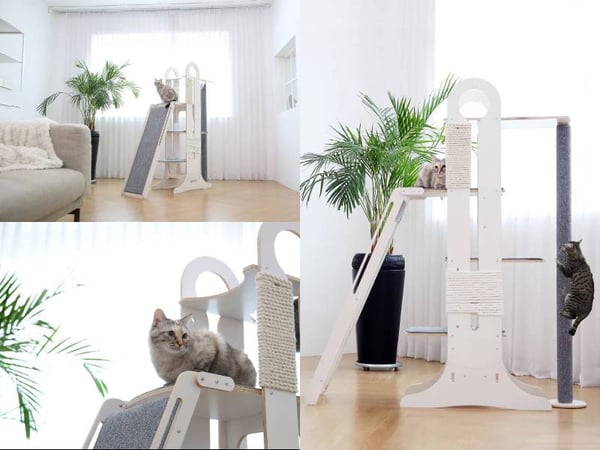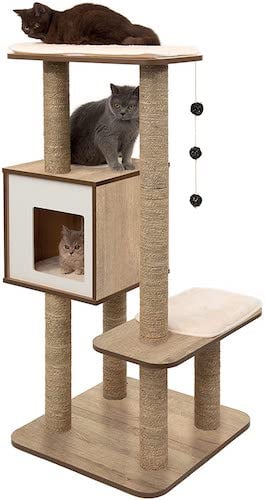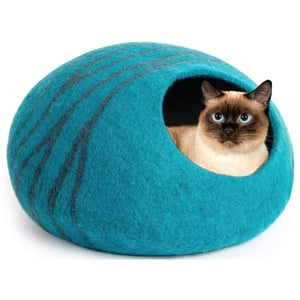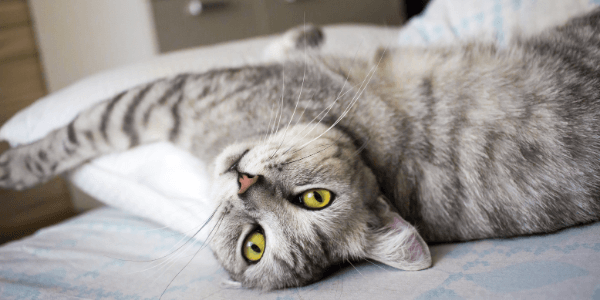 We all dream about what it would be like to be a cat. Sleep 22 out of 24 hours a day, eat and snuggle with our human. Repeat.
We all dream about what it would be like to be a cat. Sleep 22 out of 24 hours a day, eat and snuggle with our human. Repeat.
But have you ever considered why your cat may be sleeping more? Or perhaps more often?
Cat owners have started paying more attention to osteoarthritis and joint disease, and the roles they play in the overall health of our feline pals, particularly as they age.
After all, cats also have bones and joints which undergo the same remodeling as they age, just like dogs and humans.
As with so many diseases, the prevention of arthritis is better than long-term management and treatment, which may not undo all the damage. Unfortunately, there is no real cure for arthritis.
Arthritis cannot be reversed, however, it can be managed and even prevented in some cases.
The right team of experts — think your veterinarian, veterinary technician or nurse, and trained professionals — can arm you with the right knowledge to provide the best care for your feline friend, so you can help them live a longer and more comfortable life.
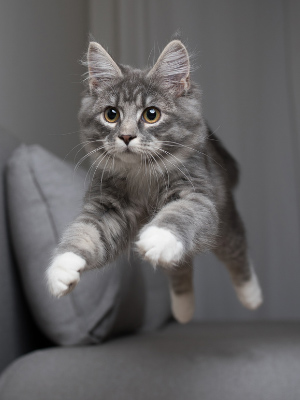 What Causes Arthritis in Cats?
What Causes Arthritis in Cats?
Any age or breed of cat can suffer from arthritis, a condition that affects nearly 40% of all cats. Because it is a degenerative disease, it is more often associated with age.
One study showed that 90% of cats have bone changes associated with arthritis visible on x-ray by the time they reach 12 years of age.
Degeneration means that over time the normal cushioning or cartilage in the joints wears down, resulting in the adjacent bones rubbing on each other.
This grinding of bones results in the formation of bone spurs, also called osteophytes, which can restrict the movement of the joint as well as other changes in and around the joint.
This leads to pain, inflammation, and discomfort for your cat.
But it's not only just due to getting older! Although it is true that arthritis occurs at a higher rate in older cats due to ‘wear and tear,’ there are still cases where degeneration can and does occur at a young age and may not be obvious to the naked eye.
We may not be aware it’s happening in our younger cats until it’s too late. In these instances, it is often due to your cat's genetics or autoimmune causes (similar to rheumatoid arthritis in people).
Or perhaps they injured themselves when they were a kitten, resulting in the development of arthritis in the healing bones.
Why Is It Hard to Recognize Arthritis in Cats?
There are several reasons why it can be difficult to recognize arthritis in cats, from their personalities to their normal survival instinct.
Cats are stoic and are natural fight-or-flight animals. They will often pretend that they are not in any pain or discomfort in order to not be preyed upon by others.
So you may not notice as quickly when your feline friend is uncomfortable. The same goes for when they are at the vet.
We often refer to this as the "cat potato" — they’ll lie on the exam table all tucked up like a potato acting as if nothing is wrong!
We, veterinarians, don't have the luxury of asking, "Excuse me, Fluffy, but does that hurt?" So we have to use our hands, brains, and our extensive training to look closely for any sign that our patient may be in discomfort.
Additionally, if you’ve ever taken your cat to the veterinarian, you know that most of the time they’re not typically super excited to be there, or for that matter to be touched by a stranger.
It can be uncomfortable and painful to have their joints manipulated, moved, or evaluated, even if it is in their best interest.
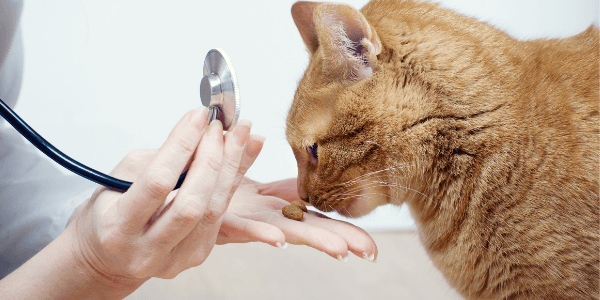
Unlike in dogs, showing overt lameness is not typically the most common clinical feature of cat arthritis. So we may not recognize that our cat is having issues until more obvious signs appear later on.
While dog owners might notice a limp or stiffness during daily walks, cats usually aren’t taking daily leashed walks with us.
For us cat owners, it’s often when we notice that they can’t (or don’t want to) jump onto their favorite high surfaces that is the giveaway that something may be up.
And this could take a while to recognize a consistent behavior — if your cat is anything like mine, they sleep 22 out of the 24 hours of the day!
How Can You Help Prevent Arthritis in Your Cat?
Although you can’t change your cat’s genetics, there are ways you can help prevent or slow the progression of arthritis.
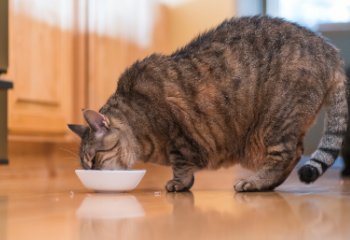
Manage Your Cat's Weight
This may sound obvious, but just like in people, it’s harder on your cat's joints when they’re overweight.
And no matter how cute they might look, being overweight is just not healthy! Extra weight makes cats prone to many more diseases, not just joint issues.
Additionally, fat cells are pro-inflammatory. Just their presence in your cat’s body is a constant low-grade cause of secondary inflammation.
Have your veterinarian calculate how much your cat should be eating — and remember this includes daily treats, too!
Feed Your Cat a Balanced and Nutritional Diet
From day one it’s important to feed an appropriately balanced, high-quality diet for the nutritional stage of your cat, be it a kitten, a nursing mother, a neutered male, spayed female, or senior cat.
These different stages of life require different nutrients, calories, vitamins, and minerals to ensure they remain healthy.
Get Your Cat Some Exercise
Keeping your cat's joints moving allows the joint fluid (synovial fluid) to move and not remain stagnant, which in turn lubricates their joints.
Think of it as similar to the way you’d apply oil to a rusty door hinge, minimizing the bone-on-bone friction we mentioned earlier.
Or when you wake up in the morning and you're stiff, but after a few minutes it wears off. It's the lubrication taking effect.
Here are some great options for indoor toys and activities for your cat to increase their exercise:
- SmartyKat Hot Pursuit Cat Toy
- Ambush Interactive Cat Toy
- Penn-Plax Spin Kitty Cat Exercise Wheel
- Da Bird Feather Wand Cat Toy
Here is a video of PV team member Mia's cat, Mazel, playing with Da Bird Feather Wand Toy:
Sure, not every cat is born to be an athlete — mine sure isn’t! But if you have a cat that likes to play with toys or will even let you put a harness on once in a while and take them for a walk, then absolutely get to it!
Did you know that you can even teach some cats to fetch for indoor exercise?
Before you throw a harness on your cat and head out the door, be sure to read how to walk your cat safely in "How to Train Your Cat to Walk on a Leash."
Start Your Cat on Joint Supplements
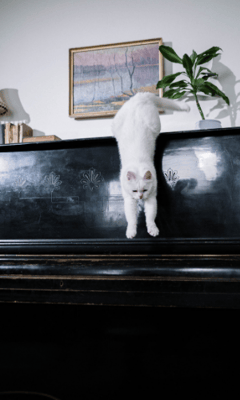 Traditionally, giving supplements to pets was more of a "dog thing." However, today there are more and more high-quality supplements available for our feline friends.
Traditionally, giving supplements to pets was more of a "dog thing." However, today there are more and more high-quality supplements available for our feline friends.
There is no specific age that has been identified as the ideal age for starting cats on supplements.
Provided you do your research and discuss the options and products with your veterinarian, there is no reason you shouldn’t be proactive and start your cat on joint supplements sooner rather than later.
While we can’t rewind arthritis, we can slow down its progression, and some joint supplements may just be able to help with this.
Fish Oil and Omega-3 Supplements
Fish oil is a natural anti-inflammatory, and it is not only great for your cat’s coat, skin, and nails, but with its anti-inflammatory properties it has been a popular option to reach for when we are concerned about preventing issues such as arthritis.
However, you’ll always want to read labels and ingredient lists, as you don’t want fish oil products that have added products such as Vitamin D, which can be toxic to pets.
And some of them, oddly enough, have xylitol, a natural sugar substitute which is toxic to cats and dogs.
While xylitol may not be as toxic to cats as it is for dogs, if you have a dog in your home it can be deadly.
To be extra safe, it’s best to stick with veterinary-formulated supplements. Nordic Naturals is easy to dispense and administer, given its liquid formulation.
Other Helpful Joint Supplements for Cats
More recently, other supplements containing not only the traditional anti-inflammatories such as fish oil or omega-3s, but also other beneficial natural products, have arrived on the pet market designed specifically for conditions such as arthritis in cats.
Some of the products I am familiar with and usually recommend are listed below:
Glycoflex by VetriScience: This contains Perna canaliculus for joint and connective tissue support as well as glucosamine and methylsulfonylmethane (MSM).
VetriScience also has a veterinarian-only version called Vetri-flex, which is one step up from their over-the-counter version.
Vetriflex contains even more good things such as curcumin and Boswellia phytosome, both proven in human studies to help reduce inflammation and support joint and connective tissue health.
Ask your veterinarian which supplement is best for your cat and their age. I have my 12-year-old cat on Vetriflex, even though she isn’t showing signs of slowing down (yet!).
I wanted to be proactive and I love that VetriScience products are backed by scientific studies that prove they work.
Dasuquin capsules and Cosequin soft chews are older but still popular supplements and have a great reputation.
Both contain glucosamine and chondroitin with some other beneficial additives, such as green tea extract and Boswellia serrata extract which have anti-inflammatory properties.
Modify Your Cat's Environment
Keep Your Cat's Climbing Safe
Cats like to jump and climb. They feel safe up high and in hidey-holes, and there is nothing wrong with that. However, what we don’t want to do is force them to jump up — or worse, jump down from these high locations daily (or multiple times a day).
This will result in repetitive forceful impacts on their joints.
Provide them with a climbing tree with different levels that they can easily jump up on to reach the next height. Or set up pet stairs or ramp for them to get onto your bed, couch, or favorite windowsill perch.
This will prevent the repetitive impact of landing on their joints which may result in micro-fractures, bone spurs, and crushing of the bones against one another, which can lead to future arthritis.
Check out our step-by-step instructions to build your own DIY cat condo that could be specific to your cats needs! And if that is too much ‘hands-on’ for you, you can also check out these great products:
Tuft and Paw's very elegant Milo Cat Tower
Provide Cozy and Joint-Friendly Cat Beds
Modifying your cat’s environment can help greatly to prevent the development of arthritis or assist with maintaining the quality of life for a cat who may already suffer from arthritis.
Use soft, comfortable beds placed in easily accessible, quiet, draft-free locations. Consider using cave-like cat beds, which can make an older cat feel warm and secure.
Put Down Non-Slip Mats
Putting down non-slip rugs or runners, even a cut-up yoga mat below your cat’s favorite window ledges or where they land or jump from frequently may help with slipping or splaying, as well as rough landings on their joints.
You can also consider stair runners or ‘stair grips’ if you have stairs to help your cats navigate these with more ease.
Paying close attention to small changes in your cat's movement and behavior may help your veterinarian determine whether your feline friend is suffering from this easily concealed disease.
After all, you know your cat best and can report what is happening to your veterinary team so they can help you and your cat!




